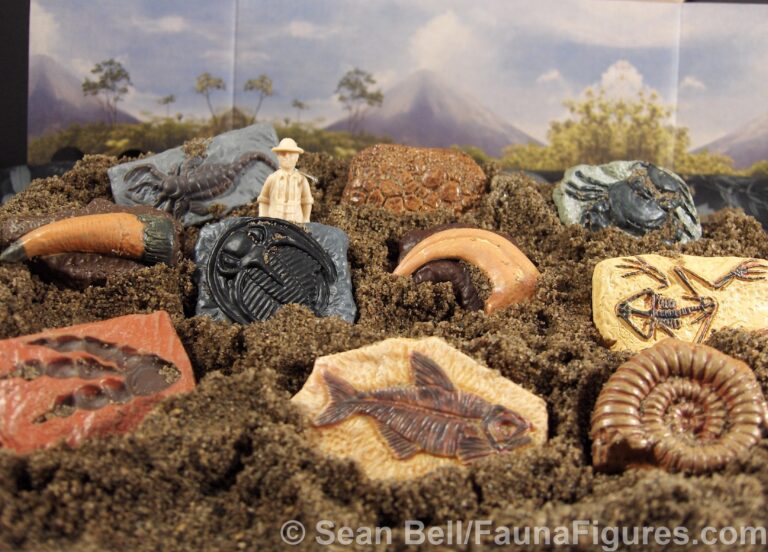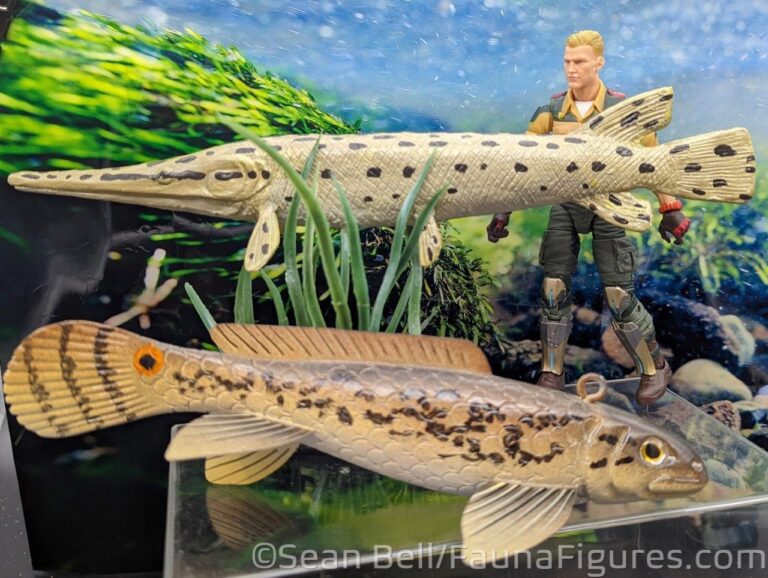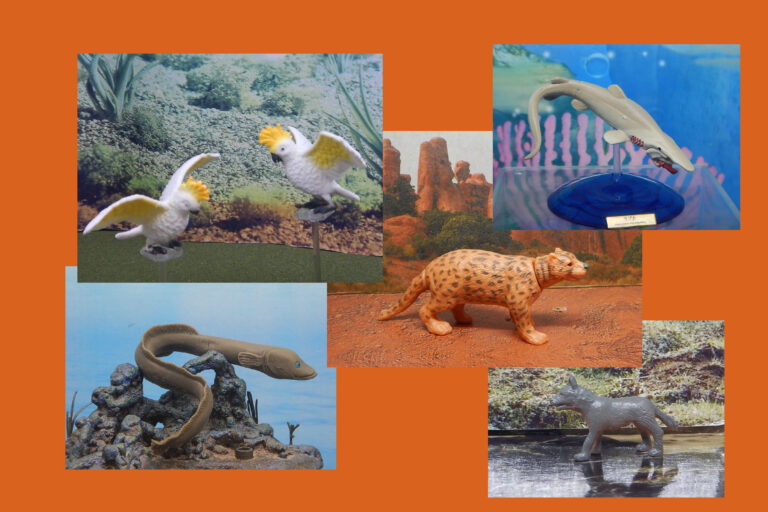I am back with another Clades post. This one is exciting because it features one of my favorite fish groups! It’s also daunting because I have a lot of representatives of this group (unlike most of the ones I’ve done) which means more to say. And also trying to sort out photo presentation… As it says in the title, it is the clade Chondrostei, the modern sturgeons and paddlefish (and of course a variety of fossil relatives…none of which are in figure or toy form that I am aware of). I have been fortunate to have gathered a fairly broad range of representatives from this group, which is fitting since, as far as modern ‘primitive fishes’ go, it is the most speciose and wide-ranging (for now…sigh). Given the figures available, I will mostly be looking at them from the point of view of the order Acipenseriformes, since that’s all I have anyway! Although I have heard of a figure of the chondrostean Birgeria but it’s one of those really old, really rare, possibly apocryphal, metal figures. So if it does exist I won’t be getting one anyway, because it would also be really expensive.
The first thing to note about the chondostreans, and that is always used in reference to them, is that they are so primitive-looking. This kind of reflects their roots, with fossils stretching back to the mid-Triassic. Even then this was a northern hemisphere group and today their distribution is nicely described as holarctic. There are species across North American, European and Asian waterways, as well as marine environments. Modern representatives can be entirely freshwater or may migrate to marine environments after spawning upstream. As a group they need unimpeded clean waterways for spawning and living, but between habitat fragmentation and harvesting, most species are at least threatened, if not endangered, critically endangered, or extinct.
The other notable feature of the group (well, the living ones) is that they are kind of shark-like at first glance. They have long, streamlined shapes with big, heterocercal tails (the upper lobe being longer than the lower), pointed snouts and under-slung mouths. They also have a similar body profile, with prominent dorsal fins and wide pectoral fins. The similarities to sharks goes even deeper though, with a skeleton that is pretty much cartilaginous except in the oldest specimens (where some ossification can occur). It is no surprise that as a group they were first classified with sharks…but I don’t think that lasted long; they are clearly bony fish, albeit ones with primitive characteristics. They also don’t have much for scales; sturgeon have five rows of sharp, bony scutes along their sides and back whereas paddlefish don’t have any scales.
I don’t think I’ve even hidden the fact that my favorite fishes, if not animals, are the primitive fish. Top of my personal list is of course the bichirs, but I am a fan of any of the modern fish thought of as ‘primitive’ or ‘prehistoric’ or ‘living fossils’–gars, bowfin, sturgeon, paddlefish, bichirs, lungfish, coelacanths…depends on what is meant by ‘primitive fish’ (often, arowana and their kin get lumped in too) since of course the phrase just refers to fish that have survived for an extended period of geologic history without changing their morphology a whole lot. Maybe we should call them ‘content in their really old adaptations’ fish. But that’s clunky. I personally just think that they’re cool and fascinating from a natural history perspective.
Sturgeon are kind of special on that front to me because, as a western Canadian, they are the only ‘primitive fish’ we have left. Lots of fossils of bowfins, and of gars…and we may have had paddlefish here at one time (seriously, they’re just south of me, in Montana!) Gar and bowfin are found further east though, although I haven’t been there to see them (and, they managed to extirpate the paddlefish too…). So it’s nice to know that I have at least one of these ‘out-survived the dinosaurs’ fish literally in my backyard; well, in the river a kilometre away where a large Lake Sturgeon was recently caught as of this writing. Maybe it’s funny how many people were surprised by that. Maybe we need to do more to let people know what’s in our waters?
All of the living chondrosteans are predators, but the two families have very different lifestyles. Sturgeon are adapted for bottom-feeding and root around for food using scent (including their nose barbels) and electroreception. It probably depends on the species and availability, but they eat fish and invertebrates. The paddlefish are more pelagic, using their weird snouts, loaded with electroreceptors, to find food in the water column. Their eyes are tiny, and given how murky their rivers can be eyesight probably isn’t much use anyway. The American species is mainly a big-mouth ram feeder, cruising along with its mouth agape and filtering food. The Chinese species was apparently more of an active predator, hunting fish as well as benthic prey.
Given their popularity with anglers, and with connoisseurs of fish eggs (which, gross, leave them in the fish to spawn), sturgeon are at least kind of familiar with people; paddlefish maybe less so since they are (were) restricted to just two areas, the Mississippi drainage and the Yangtze river basin (“were” because the Chinese paddlefish Psephurus wilsoni was recently declared extinct. Which is depressing). Although paddlefish cavoar is a thing too so that’s a thing. But overall, sturgeon and paddlefish were never easy to find as toys, models, figures…really anything. It was frustrating, but seeing as it took until the mid 90s for a decent range of sharks to appear, I guess it wasn’t surprising that the truly weird fish weren’t really available either.
It was of course the Internet that opened up the availability of some of these to me. My first sturgeon was a Colorata Chinese sturgeon–about the same time as my first Coelacanth and lungfish, I believe. Over the years, different companies have trickled along with different species. I am fortunate that of the four modern sturgeon genera, I have representatives of three (just missing Pseudoscaphirhynchus and don’t expect that to change since all three are critically endangered (maybe even extinct…). Paddlefish proved way harder. My first one is the large one several photos up–along with a bowfin, I could only find a well-crafted wooden spearfishing decoy; it’s still remarkably close to the real thing.
When it comes to sturgeon figures, there has always been a bit of a trickle–Safari Ltd released a toob just this year (2020) with a very nice Lake Sturgeon and everyone should get it (there’s several other nice figures too). And a few are still out there (the Colorata for example). Getting Paddlefish has been harder, but I have managed to gather quite an assortment, even if many are custom models or small-run models; yet oddly, the most toy-like of them all is a German squeeze toy. I would like to see more, with better availability; as always, most of these are out of Japan. And/or no longer available. I haven’t really touched on the fossil species since I don’t have any…it would be great but I wouldn’t hold my breath (except for commissioned models).
I would love to say that everyone should get as many of these as they can, but it’s not always easy. And that’s too bad. Toys and models are a great way to increase familiarity for people, and maybe motivate more advocacy. They would also be great for rounding out dioramas and projects, even for prehistoric scenes–they swam next to the dinosaurs and other ancient landscapes, let them fill out the waterways a bit! There’s hope of course; I’ve helped people source toy paddlefish for their kids (there are squishy ones made by Diramix), and I think more people would enjoy them if they were easier to get. They’re bound to get made eventually. Just need to know when and by whom!





















